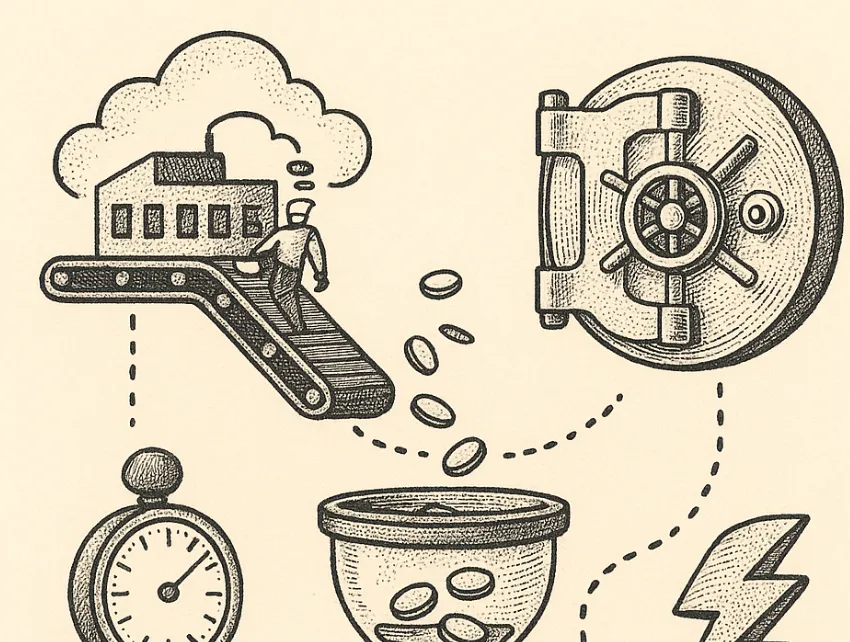
What Is Fiat Payroll? How It Compares to Crypto Payroll | Toku
Understand how fiat payroll works, its pros and cons, and how crypto payroll is changing global payments for modern teams in 2025.

.avif)
For decades, companies have relied on a simple system to pay their employees: fiat payroll. Every two weeks or once a month, money moves from a business bank account to employee accounts in a local, government-issued currency such as USD, EUR, or JPY. It’s a system that powers most of the global workforce — predictable, regulated, and deeply integrated with banking and tax infrastructure.
But the world of work has changed dramatically. Teams are now global. Developers in Singapore, designers in Argentina, and consultants in the United States often collaborate within the same company. As borders blur, the once-reliable fiat payroll system begins to show its limits. Cross-border wires are slow, exchange rates unpredictable, and banking access uneven. Even for companies that thrive in digital industries, paying international teams through traditional rails can feel surprisingly outdated.
At the same time, crypto payroll has emerged as a modern alternative — one designed for a borderless economy. Using blockchain technology and stablecoins, employers can send payments that arrive in minutes instead of days, with full transparency and lower costs. The appeal is clear: a faster, fairer way to pay global talent without the friction of banks or excessive fees.
Still, understanding the difference between fiat payroll and crypto payroll is essential before making any transition. Fiat payroll remains the foundation of most corporate payment systems — trusted, regulated, and required in many jurisdictions. Crypto payroll, on the other hand, introduces innovation, flexibility, and global reach.
This guide explores what fiat payroll is, how it works, its strengths and weaknesses, and how it compares to crypto payroll. Whether you’re an HR manager seeking efficiency or a global startup exploring blockchain-based compensation, this article will help you see how traditional systems are evolving — and how platforms like Toku make that evolution seamless and compliant.
What Is Fiat Currency?
Before understanding fiat payroll, it’s important to define the foundation it’s built on — fiat currency. The term fiat comes from Latin, meaning “let it be done.” In modern finance, fiat currency refers to money issued and regulated by governments, such as the U.S. dollar (USD), euro (EUR), British pound (GBP), or Japanese yen (JPY). Unlike commodities such as gold or silver, fiat money has no intrinsic value; its worth is derived from public trust and government backing.
In practice, fiat currencies are controlled by central banks, which manage supply, set interest rates, and influence inflation. This control allows governments to stabilize economies, fund infrastructure, and regulate employment markets — but it also concentrates monetary power in the hands of a few institutions. Every transaction, paycheck, and loan ultimately flows through the traditional banking system.
Fiat currencies remain the dominant form of money worldwide. They are accepted everywhere, integrated with tax systems, and protected by financial regulations. For most companies, they are the default medium for payroll, accounting, and employee benefits. When you receive your salary through direct deposit, you’re getting paid in fiat currency.
However, as economies become more digital and global, fiat systems face increasing pressure. Cross-border transfers can take days, international fees are often steep, and access to stable currencies is not universal. In regions with high inflation or limited banking infrastructure, fiat’s advantages quickly turn into barriers.
That’s where digital alternatives — including cryptocurrencies and stablecoins — come in. They aim to preserve fiat’s stability while removing its friction. But before diving into crypto payroll, it’s worth exploring how fiat payroll actually functions — and why it’s still the backbone of most organizations today.
What Is Fiat Payroll?
Fiat payroll refers to the traditional system companies use to compensate employees in government-issued currencies, such as USD, EUR, GBP, or JPY. It’s the process most people are familiar with — salaries are calculated in fiat currency, taxes are deducted automatically, and the remaining amount (net pay) is transferred to employees’ bank accounts.
At its core, fiat payroll operates through a centralized financial system. Every transaction must pass through banks, payment processors, and government agencies that ensure compliance with tax, labor, and financial laws. This makes fiat payroll both highly regulated and universally accepted, but it can also be slow, expensive, and difficult to scale across borders.
How Fiat Payroll Works in Practice
A typical payroll cycle includes several key steps:
- Salary Calculation: Employers determine gross pay — the total amount owed before deductions — based on hours worked or fixed salaries.
- Deductions & Taxes: Statutory deductions such as income tax, social security, or pension contributions are subtracted automatically. Example: In the U.S., this includes FICA, federal income tax, and state taxes.
- Payment Distribution: The net amount is deposited into employees’ fiat bank accounts, usually through ACH transfers, SEPA payments, or direct deposit systems.
- Reporting & Compliance: Employers submit payroll data to government agencies and generate pay slips, tax forms (like W-2 or P60), and year-end summaries.
This system has evolved over decades and is deeply embedded in financial infrastructure. Accounting software, HR tools, and tax systems are all designed around fiat payroll standards.
The Strength of Familiarity
For most businesses, fiat payroll is the default — trusted, standardized, and predictable. Employees expect to receive pay in their local currency. Governments can easily track and tax those earnings. Banks offer integrations and automation that make processing routine payroll seamless for domestic teams.
However, fiat payroll starts to show its limits in the global workforce era. When companies hire remote talent across different countries, they must navigate multiple banking systems, exchange rates, and tax jurisdictions. What’s simple for a local team can become complex and costly for an international one.
In short, fiat payroll is the backbone of traditional employment, but its design reflects a pre-digital, pre-global economy. The next sections explore why organizations are beginning to rethink this model — and how crypto payroll introduces faster, borderless, and more flexible alternatives.
5 Benefits of Fiat Payroll
Despite the growing interest in crypto and digital payments, fiat payroll remains the global standard — and for good reason. It offers stability, compliance, and reliability, especially for businesses operating within traditional banking systems. Let’s explore the key advantages that make fiat payroll the default option for most organizations today.
1. Universal Acceptance
Fiat currencies are recognized and accepted everywhere. Employees can easily use their salaries for everyday expenses, from rent and groceries to insurance and taxes. Unlike crypto, which still faces regulatory uncertainty and limited merchant adoption, fiat is backed by governments and integrated into every aspect of the economy. This universal trust gives both employers and employees peace of mind.
2. Predictability and Price Stability
Fiat money doesn’t experience the sharp price swings seen in many cryptocurrencies. A paycheck worth $3,000 today will retain roughly the same purchasing power tomorrow. This predictability simplifies budgeting for both workers and businesses, especially in industries with fixed costs and salaries. For organizations that prioritize consistency and long-term planning, fiat payroll remains the safest route.
3. Established Regulatory Framework
Fiat payroll operates under clear, well-defined legal structures. Tax deductions, labor laws, and reporting standards are fully standardized and enforced by governments. This framework protects employees’ rights and ensures companies stay compliant. HR and accounting teams also benefit from mature infrastructure — everything from direct deposit systems to tax filing software is optimized for fiat transactions.
4. Seamless Integration with Banking and HR Systems
Because fiat payroll has existed for decades, it connects effortlessly with existing tools like QuickBooks, Gusto, or ADP. Banks support automated salary transfers, and financial institutions provide reporting features that simplify reconciliation. This level of integration reduces administrative overhead and allows companies to manage payroll with minimal friction.
5. Employee Familiarity and Trust
Most employees are accustomed to receiving payments in their local currency. They understand how to check their bank accounts, pay taxes, and manage budgets using fiat. This familiarity creates a sense of trust — crucial for employee satisfaction and retention. In contrast, crypto payroll often requires education and onboarding to help employees feel confident managing digital wallets.
In essence, fiat payroll continues to dominate because it’s stable, predictable, and trusted. However, as global workforces expand and cross-border payments become the norm, even these strengths can create bottlenecks. The next section explores the limitations of fiat payroll — and why companies are increasingly exploring hybrid or crypto-based solutions to overcome them.
6 Limitations of Fiat Payroll
While fiat payroll has long been the backbone of traditional employment, its structure reveals major weaknesses in a global, digital-first economy. For companies hiring across borders or operating in fast-moving industries, the conventional system often feels slow, expensive, and outdated. Here are the key challenges that limit fiat payroll today.
1. Slow and Inefficient Cross-Border Payments
When businesses pay international employees or contractors using fiat, funds typically travel through intermediary banks, currency exchanges, and local payment networks. This process can take three to five business days — sometimes longer, depending on the destination country.
Each intermediary adds delay and cost, creating friction for both employers and recipients. In contrast, crypto transactions can settle in minutes on the blockchain, no matter where the recipient lives.
2. High Transaction and Conversion Costs
International wire transfers, currency exchanges, and intermediary bank fees make fiat payroll significantly more expensive for global teams. For example, sending $2,000 to a contractor in South America could incur $50–$100 in transfer and conversion costs. Over time, these expenses add up, especially for startups or DAOs managing dozens of international contributors.
Even modern fintech solutions like Wise or Payoneer can’t fully eliminate conversion markups or delays — they simply make them less visible.
3. Dependence on Banking Infrastructure
Fiat payroll is entirely dependent on access to traditional banking systems. Employees need valid bank accounts, which excludes millions of unbanked or underbanked workers around the world. In emerging economies, this creates inequality: talented professionals can’t participate in the global workforce simply because they lack banking access.
Crypto payroll, by contrast, only requires a digital wallet — enabling instant inclusion regardless of geography.
4. Currency Volatility and Inflation
Even though fiat is often perceived as “stable,” currencies in many regions experience high inflation or devaluation. For employees in countries like Argentina, Turkey, or Nigeria, receiving fiat payments can mean losing purchasing power within weeks.
For employers, this also complicates compensation planning — they must adjust salaries frequently to maintain fair pay across currencies. Stablecoin-based crypto payroll provides a potential solution by offering fiat-pegged stability without relying on local inflation rates.
5. Complex Compliance Across Jurisdictions
Each country enforces its own payroll, tax, and reporting requirements. Managing compliance manually across multiple regions can overwhelm finance teams. Employers must handle tax withholding, benefits, and statutory filings differently in every jurisdiction.
As a result, global payroll teams often rely on multiple vendors and legal intermediaries — leading to fragmented systems and greater operational risk.
6. Lack of Transparency and Real-Time Tracking
Traditional payroll systems rely on third parties for payment confirmation. Employers can’t easily track when a transfer clears or verify its progress in real time. Employees, too, often wait days without knowing if a payment is pending or delayed.
With blockchain-based payroll, payments are fully traceable and visible on-chain — reducing disputes and improving trust.
In summary, fiat payroll works well for domestic teams but struggles to meet the speed, cost-efficiency, and transparency demanded by global organizations. As more companies embrace remote work and cross-border hiring, the need for a faster, borderless, and compliant solution becomes urgent.
The next section compares fiat payroll to its digital-age counterpart — crypto payroll — and reveals how hybrid systems are redefining the future of global compensation.
Fiat Payroll vs. Crypto Payroll
As companies expand globally and remote work becomes standard, the question is no longer whether payroll systems should evolve — but how. The rise of crypto payroll introduces a faster, cheaper, and more inclusive alternative to traditional systems, offering global reach without sacrificing security or compliance.
To understand the shift, let’s compare how fiat payroll and crypto payroll differ in structure, speed, and flexibility — and why many modern teams now use both.
1. Defining the Two Systems
Fiat payroll uses government-issued currency and relies on banks, intermediaries, and regulatory institutions to process and record payments. Every step — from tax deductions to payment confirmations — runs through centralized systems.
Crypto payroll, on the other hand, leverages blockchain networks to pay employees or contractors directly in digital assets, such as Bitcoin, Ethereum, or stablecoins like USDC or USDT. Transactions are peer-to-peer, transparent, and verifiable on-chain.
Instead of going through banks, payments are made using digital wallets, reducing friction and transaction costs.
2. The Key Differences Between Fiat and Crypto Payroll
3. Why Crypto Payroll Is Gaining Ground
Speed and Efficiency
Blockchain networks eliminate the need for multiple intermediaries. Employers can send payments that arrive within minutes, regardless of time zones or banking holidays. For freelancers or global teams, this means instant access to funds.
Reduced Costs
Traditional payroll systems often carry hidden fees — from wire transfer costs to currency conversion rates. With crypto, transaction fees are typically just a few cents, depending on the network. Over time, this creates meaningful savings for businesses managing large teams.
Global Accessibility
Crypto payroll is inherently borderless. Anyone with a smartphone and internet access can receive payments, even in countries with limited banking infrastructure. This levels the playing field for talent worldwide.
Transparency and Auditability
Every crypto transaction is recorded on a public blockchain. Both employers and employees can verify when payments were made, how much was sent, and to which address. This transparency fosters trust — something traditional payroll systems lack.
4. The Stability Question
One of the biggest concerns about crypto payroll is volatility. Paying salaries in Bitcoin or Ethereum can expose employees to sudden value fluctuations. However, this challenge is largely addressed through stablecoins — digital assets pegged to fiat currencies like USD or EUR.
For example, paying employees in USDC ensures that each token maintains a consistent $1 value, combining the stability of fiat with the speed and transparency of crypto. This is the approach many modern payroll platforms, including Toku, use to bridge the gap.
5. Compliance and Regulation
While fiat payroll operates under well-established laws, crypto payroll is catching up quickly. Many jurisdictions now provide clear frameworks for digital asset payments, tax reporting, and KYC/AML compliance.
Platforms like Toku are built to handle these complexities — managing tax documentation, automating compliance workflows, and ensuring that global teams can be paid in crypto legally and transparently.
6. The Hybrid Payroll Model
Forward-thinking companies are not abandoning fiat altogether. Instead, they’re adopting hybrid payroll systems, offering employees the choice to receive part of their compensation in fiat and part in crypto.
This model blends the familiarity and compliance of fiat with the efficiency and innovation of blockchain. Employees can maintain financial stability while gaining exposure to digital assets — and businesses can operate globally without being limited by banking borders.
7. The Future Is Flexible
Fiat payroll isn’t disappearing anytime soon. It remains a pillar of modern finance, ensuring predictability and legal certainty. But as organizations become increasingly digital and decentralized, crypto payroll provides a way to pay faster, cheaper, and more inclusively — aligning with how global teams actually work today.
Ultimately, the shift isn’t about replacing fiat; it’s about integrating both worlds. With Toku, companies can securely bridge traditional finance and Web3 innovation — paying employees however they prefer, while staying fully compliant every step of the way.
How Companies Transition from Fiat to Crypto Payroll
Switching from traditional payroll to crypto payroll doesn’t happen overnight. For most organizations, it’s a gradual, hybrid transition that begins with experimentation and evolves into a more integrated model. The key is to move thoughtfully — balancing innovation with compliance and employee comfort.
Here’s how forward-thinking companies are making the shift in 2025.
1. Start with Fiat as the Foundation
Most companies still rely on fiat payroll for domestic employees, government compliance, and accounting consistency. It’s the foundation — especially for organizations with legacy systems or teams in heavily regulated markets.
The first step is to optimize existing fiat payroll processes: automate calculations, ensure tax accuracy, and centralize reporting. Once the system runs efficiently, adding crypto payouts becomes far easier.
2. Introduce Crypto as an Optional Benefit
Rather than overhauling payroll entirely, many companies start small — offering crypto as an optional payment method. For example, employees can choose to receive 10–20% of their salary in USDC or BTC, while the rest remains in fiat.
This approach allows HR and finance teams to test crypto infrastructure while maintaining compliance and employee trust. It also empowers workers who already hold or use crypto to manage a portion of their earnings more flexibly.
3. Use Stablecoins to Mitigate Volatility
For payroll, stability is essential. That’s why most companies transitioning to crypto payments rely on stablecoins — digital tokens pegged to fiat currencies like the U.S. dollar or euro.
By paying in USDC, USDT, or EUROC, employers maintain value stability while benefiting from the speed and efficiency of blockchain transactions. Employees can easily convert stablecoins back to fiat or keep them in digital wallets for savings or DeFi use.
4. Partner with a Compliance-Ready Platform
Crypto payroll introduces new compliance responsibilities — tax reporting, KYC (Know Your Customer), AML (Anti-Money Laundering), and regulatory disclosures. Handling all of this manually is risky and time-consuming.
That’s where Toku comes in. Toku’s platform automates the entire process, ensuring that crypto payroll operates within legal frameworks in every supported jurisdiction. Companies can pay international employees in crypto while Toku manages documentation, tax compliance, and audit trails — all from a single dashboard.
5. Educate and Support Employees
Transitioning payroll systems affects people, not just processes. Many employees may be unfamiliar with digital wallets or concerned about crypto volatility. Education is key.
Leading organizations provide internal resources, FAQs, and training sessions on how to set up wallets, secure private keys, and convert crypto safely. With proper onboarding, employees gain confidence — and crypto payroll adoption rises naturally.
6. Scale Gradually and Integrate Systems
Once crypto payroll proves effective for a segment of the workforce, companies can scale up. The goal is integration, not replacement — combining both fiat and crypto into one streamlined workflow.
Using APIs and automation, Toku connects crypto payroll directly with existing HR and accounting tools, so finance teams maintain visibility and control without doubling administrative effort.
7. The Outcome: Flexibility and Global Reach
Companies that complete this transition gain significant advantages:
- Global payment coverage with fewer intermediaries.
- Faster settlement times and lower operational costs.
- Employee choice and satisfaction, especially among Web3-native talent.
- Regulatory confidence, backed by Toku’s compliance automation.
The result is a payroll system that’s future-ready — combining the reliability of fiat with the innovation of crypto.
As more organizations embrace borderless work, hybrid payroll will become the new standard. Platforms like Toku are already helping global teams make this transition securely, ensuring every payment — fiat or crypto — is compliant, traceable, and effortless.
The Role of Fiat Payroll in a Web3 World
Even as crypto payroll gains momentum, fiat payroll remains a cornerstone of the global financial system. Governments, public institutions, and large corporations continue to rely on it for one simple reason: predictability. In a world where new payment technologies evolve rapidly, fiat offers stability, legal clarity, and deep integration into existing infrastructure.
In most countries, wages must still be denominated in fiat currency by law. Tax reporting, social security contributions, and pension deductions are all tied to national currencies. For organizations operating in heavily regulated industries — such as healthcare, finance, or government contracting — fiat payroll isn’t optional; it’s a legal requirement.
However, the rise of Web3 and decentralized finance (DeFi) is reshaping expectations. Employees and contractors — especially in tech, gaming, and blockchain sectors — increasingly want flexibility. They want to be paid in crypto, stablecoins, or a mix of both, and they expect employers to support this freedom. Fiat payroll, while traditional, must now adapt to coexist with decentralized systems rather than compete with them.
Forward-looking companies recognize that this isn’t a zero-sum game. The future of compensation lies in hybrid payroll models, where fiat and crypto complement each other. Fiat provides structure and compliance; crypto delivers speed, accessibility, and autonomy. Together, they form a seamless bridge between the established financial world and the emerging digital one.
That’s where Toku plays a critical role. As a fully compliant payroll platform designed for Web3 organizations, Toku enables companies to operate across both systems effortlessly. Businesses can fund payroll in fiat while paying employees in crypto — or vice versa — without worrying about tax exposure, audit readiness, or global compliance.
In a Web3 world, fiat payroll isn’t disappearing; it’s evolving. The companies that thrive will be those that integrate both systems intelligently, giving their teams choice, transparency, and control — the defining traits of the modern workforce.
Fiat Payroll Is Familiar, But the Future Is Borderless
For decades, fiat payroll has been the backbone of how businesses compensate their teams — a system built on trust, stability, and government oversight. It has powered the modern economy and will continue to play an essential role for years to come.
But as the world becomes more connected, the limits of fiat payroll are becoming increasingly clear. Cross-border payments, fluctuating exchange rates, and slow banking networks create friction for companies that hire globally. The next generation of organizations — especially those operating in Web3 — demand something faster, smarter, and more flexible.
That’s where crypto payroll comes in. By combining the stability of fiat with the innovation of blockchain, companies can pay anyone, anywhere, in minutes — while maintaining full transparency and compliance. The result is a payroll system that matches the pace of the digital economy.
At Toku, we believe the future isn’t about choosing between fiat or crypto — it’s about bridging both worlds. Our platform helps businesses handle every aspect of payroll seamlessly, whether in USD, USDC, or any other supported currency. With automated compliance, tax-ready reporting, and instant settlement, Toku empowers teams to operate globally without compromise.
Fiat payroll built the past. Hybrid, borderless payroll is building the future — and Toku is leading the way.
FAQ: Fiat Payroll and the Future of Crypto Compensation
1. What is fiat currency vs. cryptocurrency?
Fiat currency is government-issued money such as the U.S. dollar (USD), euro (EUR), or Japanese yen (JPY). Its value is backed by the government and controlled by central banks.
Cryptocurrency, on the other hand, is digital money secured by blockchain technology. It operates independently of central authorities and allows peer-to-peer transactions globally. Examples include Bitcoin (BTC), Ethereum (ETH), and stablecoins like USDC or USDT.
2. What exactly is fiat payroll?
Fiat payroll refers to the traditional method of paying employees in fiat currency via direct deposits, checks, or bank transfers. Taxes and deductions are handled automatically, and payments are processed through banks and regulated systems. It’s the standard model used by most organizations worldwide.
3. Is fiat payroll safe?
Yes. Fiat payroll is highly regulated and considered very secure. Government-backed financial systems protect deposits, and payroll providers must comply with strict labor, tax, and financial regulations. However, it can still be slow, expensive for cross-border payments, and inaccessible to unbanked workers.
4. Can companies legally pay employees in crypto?
Yes — in most jurisdictions, companies can legally pay in crypto, provided they comply with local labor and tax laws. Many organizations handle this through crypto payroll platforms like Toku, which automate reporting, ensure KYC/AML compliance, and convert crypto into fiat values for tax purposes.
Some countries, however, still require salaries to be denominated in fiat, so it’s essential to verify local regulations before implementing crypto payroll.
5. How does Toku handle compliance and taxes for crypto payroll?
Toku is built to make global crypto payroll fully compliant. It automatically manages KYC (Know Your Customer) verification, AML (Anti-Money Laundering) checks, and local tax requirements.
Employers can pay contractors or employees in crypto while Toku handles documentation, conversions, and audit-ready records — simplifying what would otherwise be a complex process.
6. What’s the future of payroll systems?
The future is hybrid. Fiat payroll will remain essential for compliance and stability, but crypto payroll will continue to expand due to its efficiency and global reach. Companies that adopt both systems gain the flexibility to pay anyone, anywhere, in their preferred currency — securely and instantly.
7. Why should businesses consider Toku for payroll modernization?
Because Toku bridges both worlds. It enables organizations to pay in fiat, crypto, or a mix of both — all while ensuring full compliance and tax readiness. Whether your team is local or global, Toku simplifies payroll into one secure, scalable platform for the modern workforce.







